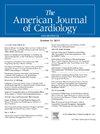通过使用三维经食道超声心动图分析二尖瓣狭窄患者的二尖瓣几何形状确定井上球囊大小
IF 2.3
3区 医学
Q2 CARDIAC & CARDIOVASCULAR SYSTEMS
引用次数: 0
摘要
在对二尖瓣狭窄(MS)患者进行经皮二尖瓣球囊扩张术(PMBC)时,球囊的大小传统上是根据患者的身高或体表面积粗略决定的。我们的目的是通过使用三维经食道超声心动图(TEE)定量分析二尖瓣(MV)的几何形状来评估球囊大小选择的临床价值。在 184 名连续接受 PMBC 的患者中,对二尖瓣瓣环在舒张中期的几何形状进行了分析,包括通过专用三维软件(LMD-3d)或使用多平面重建图像(LMD-mpr)分析获得的外侧-内侧直径的测量结果。患者被分为三组:PMBC 成功后的患者(SU 组)、二尖瓣狭窄残留的患者(MS 组)和有明显 MR 的患者(MR 组)。SU、MS 和 MR 组分别包括 110、50 和 17 名患者。我们比较了基于患者身高或体表面积的三个传统公式(公式 1、2、3)和根据 SU 组数据得出的两个新公式:球囊大小 = 0.0684 × LMD-3d + 24.309(公式 4)和 0.061 × LMD-mpr + 24.573(公式 5)。与使用公式 4 计算出的球囊尺寸相比,充气后的球囊尺寸明显较小(-0.78±1.02;p本文章由计算机程序翻译,如有差异,请以英文原文为准。
Determination of Inoue Balloon Size by Analysis of Mitral Valve Geometry Using Three-Dimensional Transesophageal Echocardiography in Patients With Mitral Stenosis
In percutaneous mitral balloon commissurotomy (PMBC) for patients with mitral stenosis (MS), the size of the balloon has traditionally been determined using a crude method based on the patient's height or body surface area. We aimed to evaluate the clinical value of balloon size selection by quantitatively analyzing mitral valve geometry using 3-dimensional (3D) transesophageal echocardiography. In 184 consecutive patients who underwent PMBC, the geometry of the mitral valve annulus was analyzed during mid-diastole, including the measurement of lateral-medial diameters obtained from dedicated 3D software or from analysis using multiplanar reconstruction images. Patients were categorized into 3 groups: those with successful results after PMBC (SU group), those with residual mitral stenosis (MS group), and those with significant MR (MR group). The SU, MS, and MR groups included 110, 50, and 17 patients, respectively. We compared 3 conventional formulas (formulas 1, 2, and 3) based on the patient's height or body surface area, with 2 new formulas derived from data in the SU group: balloon size = 0.0684 × lateral-medial diameters obtained from dedicated 3D software + 24.309 (formula 4) and 0.061 × lateral-medial diameters obtained from analysis using multiplanar reconstruction images + 24.573 (formula 5). Compared with the calculated balloon sizes using formula 4, the inflated balloon sizes were significantly smaller (−0.78 ± 1.02, p <0.001) in the MS group, whereas they were significantly larger (0.56 ± 1.05, p = 0.04) in the MR group. This pattern was also consistent in formula 5. In conclusion, selecting the Inoue balloon inflation size based on the mitral annulus diameter determined by 3D transesophageal echocardiography might be a reasonable approach.
求助全文
通过发布文献求助,成功后即可免费获取论文全文。
去求助
来源期刊

American Journal of Cardiology
医学-心血管系统
CiteScore
4.00
自引率
3.60%
发文量
698
审稿时长
33 days
期刊介绍:
Published 24 times a year, The American Journal of Cardiology® is an independent journal designed for cardiovascular disease specialists and internists with a subspecialty in cardiology throughout the world. AJC is an independent, scientific, peer-reviewed journal of original articles that focus on the practical, clinical approach to the diagnosis and treatment of cardiovascular disease. AJC has one of the fastest acceptance to publication times in Cardiology. Features report on systemic hypertension, methodology, drugs, pacing, arrhythmia, preventive cardiology, congestive heart failure, valvular heart disease, congenital heart disease, and cardiomyopathy. Also included are editorials, readers'' comments, and symposia.
 求助内容:
求助内容: 应助结果提醒方式:
应助结果提醒方式:


